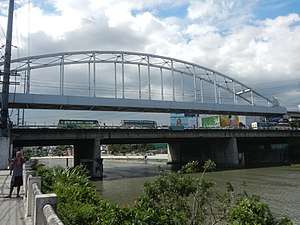Guadalupe Bridge
| Guadalupe Bridge Tulay ng Guadalupe | |
|---|---|
 Guadalupe Bridge in 2017. | |
| Carries | 10 lanes (5 lanes each direction) of EDSA |
| Crosses | Pasig River |
| Locale | Makati and Mandaluyong, Philippines |
| Characteristics | |
| Material |
Prestressed and reinforced concrete (Outer bridges) |
| Total length |
Inner bridge: 135 m (443 ft) Outer bridges: 114.44 m (375.5 ft) |
| Width |
Inner bridge: 9.1 m (30 ft) Outer bridges: 18.7 m (61 ft) each |
| No. of lanes | 10 (5 per outer bridge) |
| History | |
| Construction end | 1979 |
| Statistics | |
| Daily traffic | 220 thousand vehicles (2013) |
The Guadalupe Bridge is a road bridge that connects the cities of Makati and Mandaluyong in Metro Manila, Philippines
Background
The Guadalupe Bridge which is part of the Epifanio De los Santos Avenue consists of an inner bridge and two outer bridges.[1] The two outer bridges were constructed in 1979 with Umali-Pajara Construction Company as its general contractor. The length of the bridge from its two abutments is 114.44 meters (375.5 ft).[2] The outer bridges have 10 lanes in total and a junction at the Makati side of the bridge connects to J. P. Rizal Avenue. Each outer bridge is around 18.7 meters (61 ft) in width, has 5 lanes that measures 3.35 meters (11.0 ft) each and a 1.2 meters (3.9 ft) pedestrian sidewalk near the railings.[3]
A separate but unconnected rail bridge of the Manila Metro Rail Transit System (MRT-3) line exists above the road bridge. The rail bridge that hovers above the road bridge was constructed by the EEI Corporation has a length of 135 meters (443 ft) and a width of 9.1 meters (30 ft).[4]
According to a December 2013 report by JICA, the Guadalupe Bridge has the highest traffic volume among 12 main bridges in Metro Manila.[5] with 220 thousand vehicles crossing the bridge daily.[3]
Planned renovation
By 2016, the bridge has been identified as one of the structures expected to collapse following a hypothetical strong earthquake in Metro Manila.[6] Major repairs is set to be done on the bridge in 2019.[7]
The outer bridges will be replaced by three-span steel deck box girders while the inner bridge assessed by JICA to be in good condition will just be retrofitted.[1] The pedestrian sidewalk will be expanded to 1.5 meters (4.9 ft) while the outer bridges will still have 10 lanes in total.[8]
References
- 1 2 de Vera, Ben; Esplenada, Jerry (2 September 2015). "Japan finances repair of 2 vital Metro bridges". Philippine Daily Inquirer. Retrieved 8 January 2018.
- ↑ "Feasibility Study of the Guadalupe Bridge Rehabilitation Plan" (PDF). JICA. Retrieved 8 January 2018.
- 1 2 "The Project For Study on Improvement of Bridges Through Disaster Mitigating Measures for Large Scale Earthquakes in the Republic of the Philippines - Final Report" (PDF). JICA. December 2003. pp. 15–172. Retrieved 8 January 2018.
- ↑ "Infrastructure - Finished Projects". EEI Corporation. Retrieved 8 January 2018.
- ↑ "The Project For Study on Improvement of Bridges Through Disaster Mitigating Measures for Large Scale Earthquakes in the Republic of the Philippines - Final Report" (PDF). JICA. December 2003. pp. 15–134. Retrieved 8 January 2018.
- ↑ Nacino, Alysha (25 June 2016). "What happens to Guadalupe Bridge during a quake?". Rappler. Retrieved 8 January 2018.
- ↑ Sausa, Raadee (24 November 2016). "Guadalupe bridge to undergo major repair". Manila Times. Retrieved 8 January 2018.
- ↑ "The Project For Study on Improvement of Bridges Through Disaster Mitigating Measures for Large Scale Earthquakes in the Republic of the Philippines - Final Report" (PDF). JICA. December 2003. p. 15-174-15-176. Retrieved 8 January 2018.